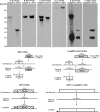Creation of a recombinant Rift Valley fever virus with a two-segmented genome
- PMID: 21795328
- PMCID: PMC3196426
- DOI: 10.1128/JVI.05252-11
Creation of a recombinant Rift Valley fever virus with a two-segmented genome
Abstract
Rift Valley fever virus (RVFV; family Bunyaviridae) is a clinically important, mosquito-borne pathogen of both livestock and humans, which is found mainly in sub-Saharan Africa and the Arabian Peninsula. RVFV has a trisegmented single-stranded RNA (ssRNA) genome. The L and M segments are negative sense and encode the L protein (viral polymerase) on the L segment and the virion glycoproteins Gn and Gc as well as two other proteins, NSm and 78K, on the M segment. The S segment uses an ambisense coding strategy to express the nucleocapsid protein, N, and the nonstructural protein, NSs. Both the NSs and NSm proteins are dispensable for virus growth in tissue culture. Using reverse genetics, we generated a recombinant virus, designated r2segMP12, containing a two-segmented genome in which the NSs coding sequence was replaced with that for the Gn and Gc precursor. Thus, r2segMP12 lacks an M segment, and although it was attenuated in comparison to the three-segmented parental virus in both mammalian and insect cell cultures, it was genetically stable over multiple passages. We further show that the virus can stably maintain an M-like RNA segment encoding the enhanced green fluorescent protein gene. The implications of these findings for RVFV genome packaging and the potential to develop multivalent live-attenuated vaccines are discussed.
Figures








References
-
- Bird B. H., Albariño C. G., Nichol S. T. 2007. Rift Valley fever virus lacking NSm proteins retains high virulence in vivo and may provide a model of human delayed onset neurologic disease. Virology 362:10–15 - PubMed
Publication types
MeSH terms
Grants and funding
LinkOut - more resources
Full Text Sources
Other Literature Sources
Miscellaneous

